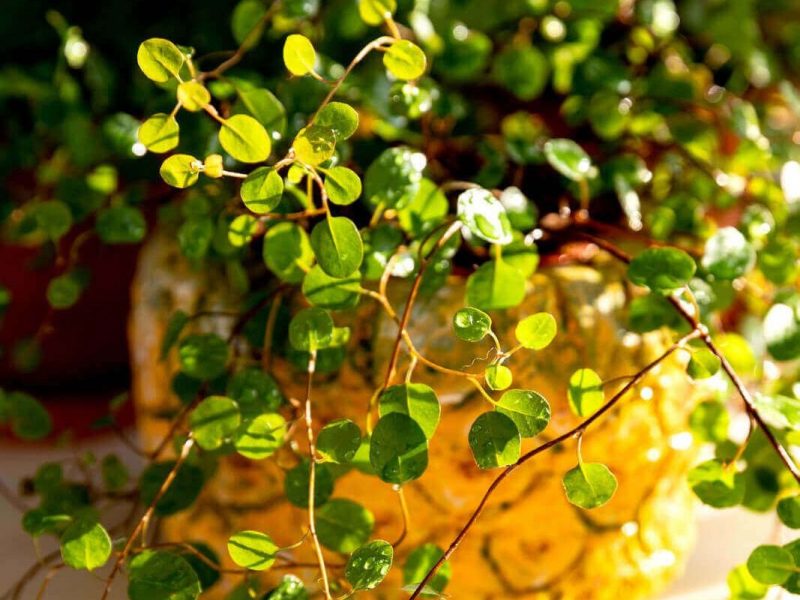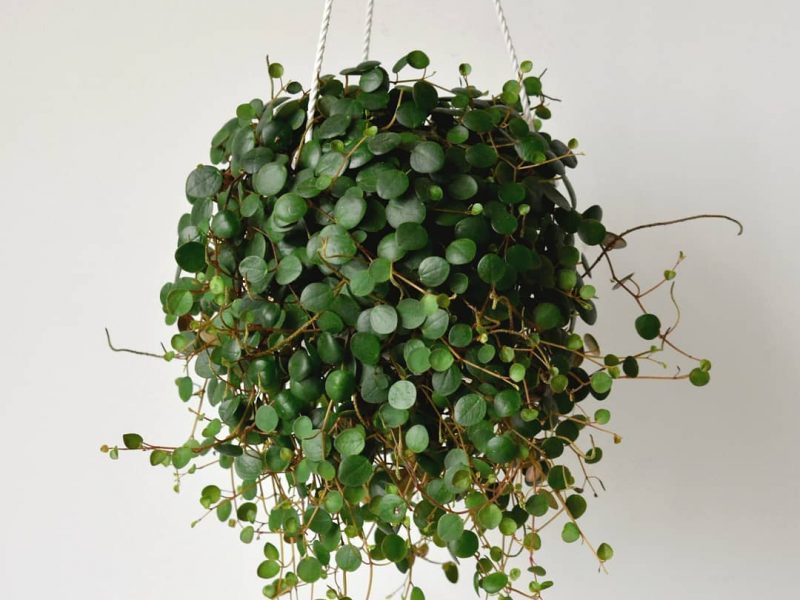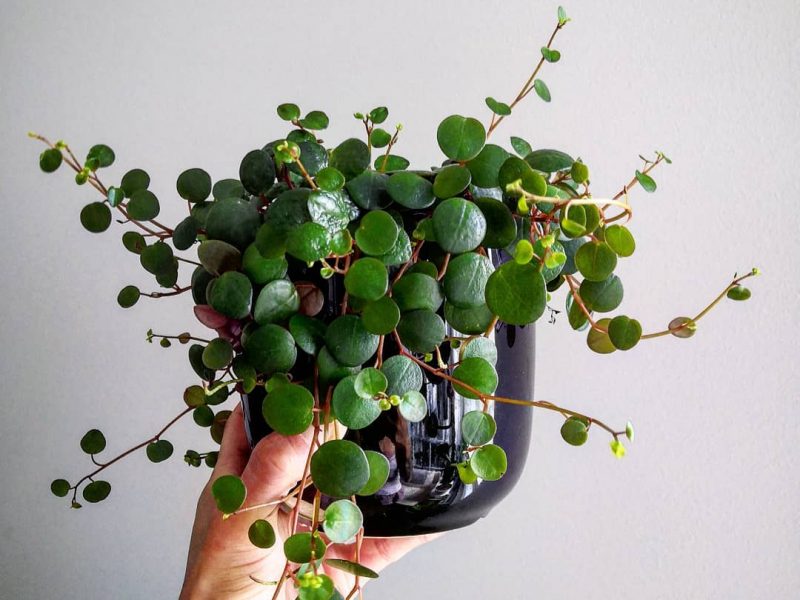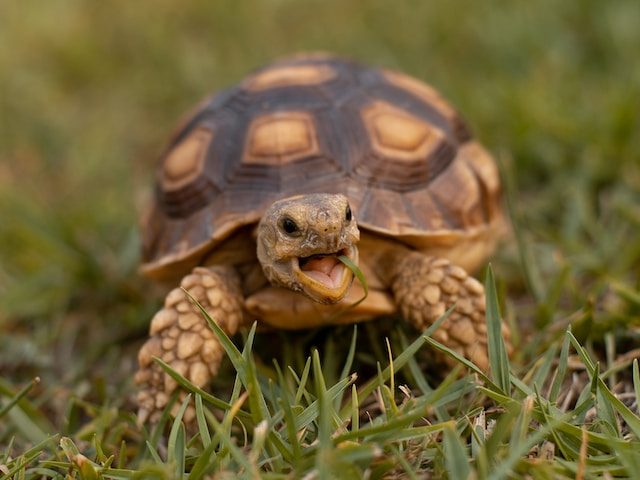Peperomia Pepperspot Plant

The Pepperspot variety of Peperomia can be a little difficult to get your hands on but totally worth it if you can! Native to South and Central America, the Peperomia Pepperspot is iconic for its tiny round leaves on a mess of thin little vines.
In this care guide, we will share with you all of the Peperomia Pepperspot’s environmental requirements, as well as how to repot, prune and propagate it. Scroll right to the bottom for more information on how to diagnose and treat common problems.
How to care for a Peperomia Pepperspot
It’s important that the Peperomia Pepperspot gets a lot of bright but indirect light. If grown in low-light areas they can very quickly become leggy and straggly. On the opposite end of the spectrum, if exposed to intense direct sun, it can dry out the thin leaves and stems very quickly.
When it comes to watering your Peperomia Pepperspot, make sure that the soil dries out fully between watering. They have quite a delicate root system so are sensitive to overwatering. Even the occasional accidental overwatering can lead to root rot and consequent issues.
Peperomia Pepperspot Overview
Origin: Native to South and Central America
Plant Family: Piperaceae family
Difficulty Level: Medium
Common Names: Peperomia Pepperspot, Green Coins Plant
Appearance: Small round green leaves on very thin red stems.
Height and Size: Average mature length of 16 inches (40 centimeters)
Growth Rate: Slow
Flowering: Rare but may occasionally grow small, insignificant flowers in summer
Pruning: Remove dead or dying leaves and prune to keep them in the desired shape and size
Cleaning: Use a feather duster to delicately clean the leaves
Light Requirements: Bright, indirect light. Will become leggy in low light.
Water Requirements: Water once weekly in summer, allowing the soil to dry out in between
Best Soil: Loose and well-draining potting mix
Ideal temperature: 65-85°F (18-29°C)
Fertilizing Routine: Apply a well-balanced fertilizer at half the recommended strength once a month during the growth season.
Ideal Humidity Level: 50-60% humidity
Propagation: Through vine cuttings
Repotting Frequency: Every 1-2 years
Toxicity: Non-toxic and safe for humans and pets
Risk of Pests: Mealybugs, aphids and spider mites.
Common Problems: Leggy growth and dry brown leaves
Origin of a Peperomia Pepperspot
They are native to areas across South and Central America and grow under the canopy of other larger trees. This is why they require bright but indirect light as they won’t be able to tolerate direct sunlight.
Peperomia Pepperspot Family
They are part of the Piperaceae family (also known as the Pepper family) which contains five genera: Piper, Peperomia, Zippelia, Manekia, and Verhuellia. There are over 3,500 species across these genera but most lie within the two main genera: Piper and Peperomia
Peperomia Pepperspot Appearance
The Peperomia Pepperspot is often mistaken for other Peperomia with small round leaves but there are several distinctive characteristics of this variety. They have very very small thin leaves that hang off thin red stems. The plant can look a little messy as the vines don’t always just grow straight so it can end up looking like a big bush of tiny leaves.
Care Difficulty Level
Despite having very delicate small leaves, the Peperomia Pepperspot is actually easier to care for than it looks. The hardest part tends to be getting your hands on one of these to begin with but once you’ve found a good spot for them, they are quite easy to look after as they have very standard care requirements.
Peperomia Pepperspot Height and Size
The Peperomia Pepperspot will tend to grow to a maturity of 16 inches (40 centimeters) in height and spread. They will take many years to get to this maturity so they won’t outgrow the space any time soon.
Peperomia Pepperspot Growth Rate
Like most Peperomia plants, the Green Coins Plant is quite a slow grower, making them perfect for small spaces. You will still see plenty of new growth every year but it won’t be popping out new leaves whenever you look at it.
Flowers on a Peperomia Pepperspot
Peperomia Pepperspot plants will very rarely bloom when grown indoors as houseplants. However, you may see tiny flowers appear in spring and summer but these will be very insignificant and won’t last long.
Pruning your Peperomia Pepperspot
There are two main reasons that you will need to prune your Peperomia Pepperspot; to remove dead/dying leaves and to keep your plant in the desired shape.
Once a leaf or stem has turned brown or yellow, there is no reversing this. Instead, the best thing to do is prune it from your plant. The dead leaves will eventually fall off but it’s best to prune them as soon as it happens. This allows your plant to focus all of its energy on new growth.
The second reason you may need to (or want to) prune your Peperomia Pepperspot is to shape it. These plants can become a bit messy and unruly so pruning can help to keep them the size or shape that you want.
You may also choose to prune any leggy growth that may have formed over winter. When your plant isn’t getting enough sunlight, the vines can start to become quite leggy and there will be large gaps between each leaf on the vine. Although this won’t cause any damage to your plant or impact its health, removing it can help your plant look fresher.
Cleaning your Peperomia Pepperspot
Cleaning this variety of Peperomia can be a little tricky to clean as they have very thin, delicate leaves and stems that can be easily broken. The best way to clean them is using a very soft feather duster to brush off dust and dirt from the leaves.
@hellodeka on Instagram

Light Requirements for a Peperomia Pepperspot
Peperomia Pepperspot natively grow beneath the Amazonian canopy so don’t deal well with direct light and it can scorch the leaves. You’ll want to find a spot with amble bright but indirect light.
While they can adapt to some medium light levels, they will start to become leggy and straggly in low light. It may also cause them to start dropping leaves.
Water Requirements for a Peperomia Pepperspot
Peperomia Pepperspots need a good watering every week during summer but you want to make sure that the potting mix has dried out slightly before watering again. This will help to avoid waterlogged soil and root rot. Cut back watering in winter to every other week to ensure there is enough time for the soil to still dry out.
There are a few ways to know if the soil has dried out, the most reliable of which is a moisture meter. However, if you don’t have one (or don’t want to invest) then we recommend the lifting method. Start to lift your plant up regularly after watering and you will slowly become accustomed to what it feels like weight-wise with dry potting mix.
Best Soil for a Peperomia Pepperspot
A loose and well-draining potting mix is ideal for your Peperomia Pepperspot. The most important ingredient is perlite which helps with drainage and aeration. You can find a lot of potting mixes that already include it but you can buy it separately and add it yourself too!
Ideal temperature for your Peperomia Pepperspot
The ideal temperature range for the Pepperspot is 65-85°F (18-29°C). They prefer slightly warmer temperatures and will struggle in cold air. It’s important that you keep them away from drafty windows, external doors and air conditioning vents as over time this can cause issues such as brown leaves, leggy growth, stagnant growth and your Peperomia losing leaves.
But it’s not just cold extremes that you need to watch out for as hotspots can be equally damaging to your plant. This is anything about 85°F (29°C) for extended periods of time. It’s not just intense sunlight through the window that can cause these hotspots. If your plant is too close to a cooker, radiator or heating vent, it can dry out the leaves and stems very quickly.
The best thing to do is buy a digital thermometer to monitor for any extremes and make changes before it causes issues for your plant.
Peperomia Pepperspot Fertilizer Requirements
Apply a well-balanced 10-10-10 fertilizer at half the recommended strength once a month during the growth season. The reason that you should always use less than the recommended amount is to reduce the risk of overfertilization. If given too much fertilizer, it can cause issues such as yellow leaves, stunted growth or small new leaves.
Cut back on fertiliser completely during winter as growth will be dormant and feeding during this time can be really damaging to your plant and its root system.
Peperomia Pepperspot Humidity Requirements
On average, your Green Coins Plant requires a humidity level of 50-60% to thrive. The best way to boost the humidity is to mist the plant a few times a week or use a humidifier. This will go a long way to preventing brown leaves on your Peperomia Pepperspot.
The only real way to measure the humidity around your plant is to use a humidity monitor. Luckily a lot of digital thermometers have this included so you can get a 2-in-1 combo device.
@roosanur on Instagram

Propagating your Peperomia Pepperspot
The process for propagating your Peperomia Pepperspot is about as easy as it gets. To start make sure that you have a healthy and mature parent plant, this gives your a slightly higher success rate and will also lower the risk of causing problems with the starter plant.
Next, with some clean sharp shears or scissors, snip off some cuttings from the stems. Take these stems and submerge the bases in some water, these should start rooting pretty quickly. Once you have some leaves and a good healthy root ball go ahead and plant them into some good quality potting mix and continue care as normal.
Repotting your Peperomia Pepperspot
As they are quite slow growers, you won’t need to repot your Peperomia Pepperspot often, on average every 1-2 years. However, you should regularly keep an eye out for signs that your plant is rootbound and may benefit from a new, bigger pot.
These signs include roots growing out of the bottom or top of the pot, the roots being tightly coiled when removed from the pot (there won’t be much soil left if rootbound) and stagnant growth.
Stagnant growth can be caused by other factors other than a rootbound Peperomia Pepperspot though so be sure to check other care and environmental factors before making the diagnosis.
Peperomia Pepperspot Toxicity to Humans and Pets
Peperomia Pepperspot plants are safe and non-toxic for humans and pets, including cats, dogs and bunnies. Whilst you still want to avoid your pet consuming large quantities of it, it’s not dangerous if they come into contact with it or nibble at it slightly.
Treating and Preventing Pests
Although it’s very uncommon, it may occur that your Peperomia Pepperspot begins to suffer from a pest infestation. This tends to be common on houseplants that spend some of the year growing outside on balconies or in the garden so make sure to thoroughly check them when moving them back inside for the winter.
A pest infestation of any kind can very quickly begin to cause a range of issues from brown and yellow leaves to holes in the leaves and stunted growth. If not treated in time, it can also kill your plant.
Here is a list of some of the pests that pose a danger to the Peperomia Pepperspot:
Spider Mites: They are very very small and difficult to spot with the naked eye so you’ll need to diagnose this by using a magnifying glass and spotting the issues they cause (yellow and brown spots). The reason that they are so damaging to Peperomia Pepperspot plants (and other houseplants) is that they feed on the sap of the plant, dehydrating it and killing it. As Pepperspots have very small thin leaves, they can kill the leaf very quickly. To treat, use neem oil and an insecticide.
Aphids: Aphids are small, soft-bodied insects that also suck on the plant sap but they leave behind a sticky dew which makes them easier to diagnose. Remove aphids by gently spraying your plant with an insecticide.
Mealybugs: Mealybugs are white insects that almost look like tiny fluffs of cotton across the leaves and vines of your Peperomia. These sap-feeding bugs dehydrate the leaves quickly and lead to stunted growth. The best way to remove mealybugs is by using a cotton swab that has been dabbed in alcohol but this can be a tedious task for this Peperomia variety.
Having success when fighting a pest infestation is difficult but spotting the issue early is key. Monitor your plant regularly and give it thorough checkups about once a month to spot any early warning signs of pests or other problems.
Peperomia Pepperspot Common Problems
Why is my Peperomia Pepperspot leggy?
Without sufficient light, your Peperomia Pepperspot may become leggy as it tries to reach enough light. Move your plant to a slightly sunnier spot and trim away the leggy growth if you prefer.
Why does my Peperomia Pepperspot have yellow leaves?
Yellow leaves on a Peperomia Pepperspot can indicate either too much water or too much sunlight. If the plant gets too much light the yellow patches will look scorched and burnt. Check the soil to see if watering issues are the problem and adjust watering or environment accordingly.
Why is my Peperomia Pepperspot losing leaves?
Overwatering is most commonly the reason that Peperomia Pepperspot lose their leaves as they have very delicate roots and stems. If the soil is waterlogged for too long, the roots will begin to rot and your plant will drop leaves as a result. Check the potting mix and replace the soil immediately if waterlogged. Don’t wait for it to dry out naturally as this risks your plant losing even more leaves.
It’s also important to know that Peperomia Pepperspot plants lose their leaves quite frequently as part of their natural ageing process. This leaf drop isn’t the result of any problem, it’s just a natural process that allows your plant to focus energy on growing new bigger leaves. If your plant is growing more leaves than it is losing, and the rate of leaf drop isn’t increasing, then you probably don’t have anything to worry about.
Why does my Peperomia Pepperspot have brown leaves?
Brown leaves on a Peperomia Pepperspot are most commonly caused by either watering issues, or a lack of humidity.
Both underwatering and overwatering can cause your Peperomia Pepperspot to turn brown but there are distinct differences to help you diagnose the problem correctly. Underwatering will cause the leaves on your plant to become quite crispy and light brown in colour whereas overwatering will turn the leaves quite dark brown and soft to touch. Check the moisture levels in the potting mix and adjust your watering schedule moving forward.
If the leaves on your Peperomia Pepperspot are becoming quite brown and crispy, but there is no issue with watering, then it might also be a lack of humidity that is the cause. Mist your plant daily and this should prevent any more brown leaves from developing.
Why is my Peperomia Pepperspot drooping?
The most common cause of a drooping Green Coins Plant is a lack of moisture. If the potting mix has been dry for too long, and your plant is dehydrated, it will begin to droop as the stems become floppy. Give your plant plenty of water if the soil is dry and you should see your plant stop drooping in a matter of hours.
Your plant might also droop down as a result of temperature stress. They don’t deal so well with cold temperatures so if they are next to a draft window or door, this might be causing your plant to droop.
Why does my Peperomia Pepperspot have curling leaves?
This can be quite a subtle issue to spot as their leaves are so small, but it can happen that Peperomia Pepperspot plants curl their leaves in response to direct sunlight. It’s important that your plant doesn’t receive any intense sunlight as their leaves are so delicate and they can burn easily. Before scorching, your Peperomia Pepperspot will curl its leaves to shield itself from that direct sun.
Luckily, the fix is super simple as you just need to find a slightly shadier spot for your plant and their leaves should gradually uncurl.














